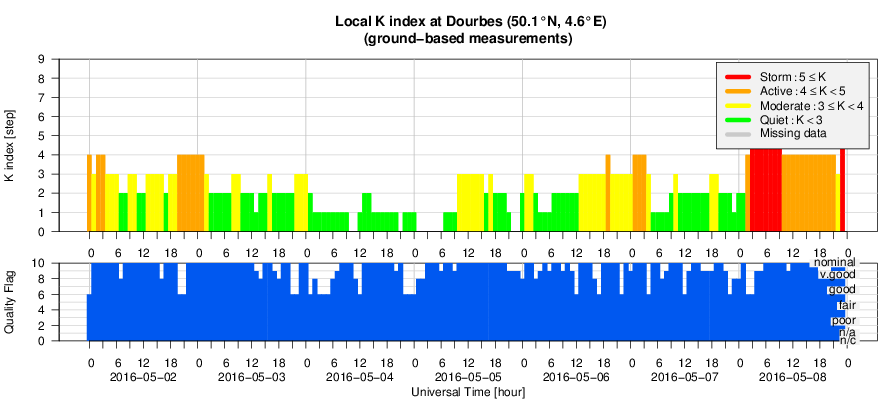- Table of Content
- 1.Mercury transi...
- 2.PROBA2 Observa...
- 3.Review of sola...
- 4.The Internatio...
- 5.Review of geom...
- 6.Geomagnetic Ob...
- 7.Review of iono...
- 8.New documents ...
- 9.Future Events
2. PROBA2 Observations (2 May 2016 - 8 May 2016)
3. Review of solar activity
4. The International Sunspot Number
5. Review of geomagnetic activity
6. Geomagnetic Observations at Dourbes (2 May 2016 - 8 May 2016)
7. Review of ionospheric activity (2 May 2016 - 8 May 2016)
8. New documents in the European Space Weather Portal Repository
9. Future Events
Mercury transits the Sun
The Mercury transit of 09 May generated quite some interest from the media and the general public. The STCE created a website at http://www.sidc.be/transit2016/ with imagery from the USET solar telescopes and the satellites PROBA2 and SDO. There was also a page with coronagraphic imagery from SOHO/LASCO (before/after transit day), as well as a page where solar observers could upload there own pictures of the event.
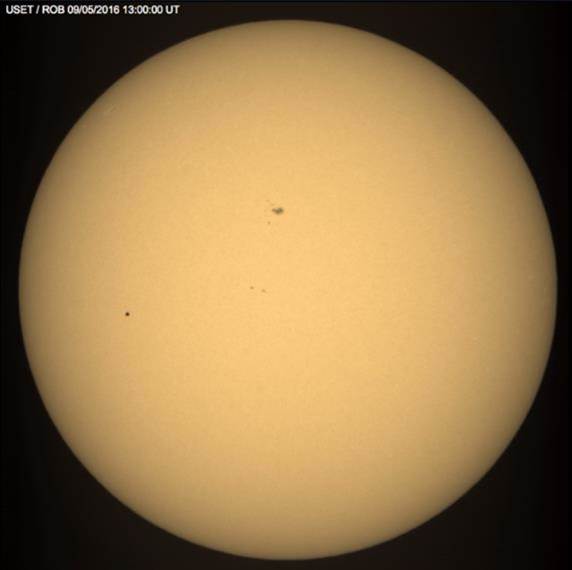
The solar telescopes in Uccle (http://www.sidc.be/uset/) observed the Sun in white light, H-alpha (red part of the spectrum) and Calcium IIK (violet part of the spectrum). The images got a dedicated colour to distinguish one wavelength from the other. Clouds interfered regularly with the observations, but the first half of the transit was well covered. Far above the clouds, solar satellites were able to observe the entire event. Even the PROBA2/SWAP telescope, observing the Sun in extreme ultraviolet at a modest resolution, was able to image relatively well Mercury's puny silhouette. Plenty of clips and images can be found at PROBA2's special webpage for this phenomenon (http://proba2.oma.be/Events/2016-May-09-MercuryTransit/ ).

The Planetarium at the Heysel (http://www.planetarium.be/frontpage.php ) was open to the general public. A few hundred of interested visitors and school children took a look through the solar telescopes, and got plenty of explanations from the guides. Also the media were present and reported extensively in the news and on their webpages. The next Mercury transit will take place on 11 November 2019 (http://eclipse.gsfc.nasa.gov/transit/catalog/MercuryCatalog.html ), but will only be partially visible from Belgium.
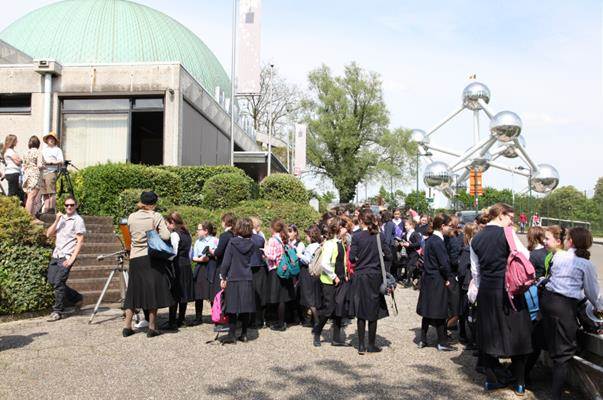
PROBA2 Observations (2 May 2016 - 8 May 2016)
Solar Activity
Solar flare activity fluctuated between very low and low during the week.
In order to view the activity of this week in more detail, we suggest to go to the following website from which all the daily (normal and difference) movies can be accessed:
http://proba2.oma.be/ssa
This page also lists the recorded flaring events.
A weekly overview movie can be found here (SWAP week 319).
http://proba2.oma.be/swap/data/mpg/movies/weekly_movies/weekly_movie_2016_05_02.mp4
Details about some of this week’s events, can be found further below.
Monday May 02
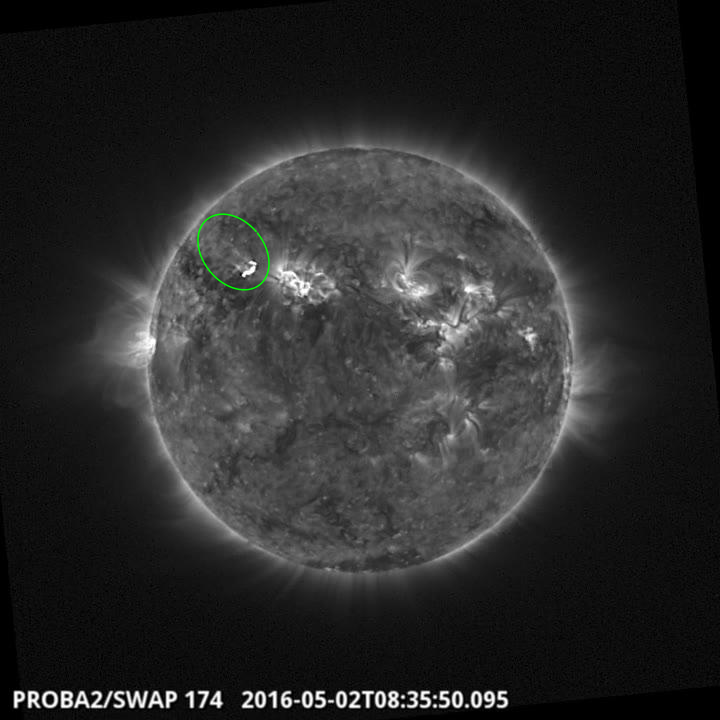
An eruption was observed by SWAP in the NorthEast quadrant of the Sun at 08:35 UT on 2016
May 02
Find a movie of the events here (SWAP movie)
http://proba2.oma.be/swap/data/mpg/movies/20160502_swap_movie.mp4
Wednesday May 04
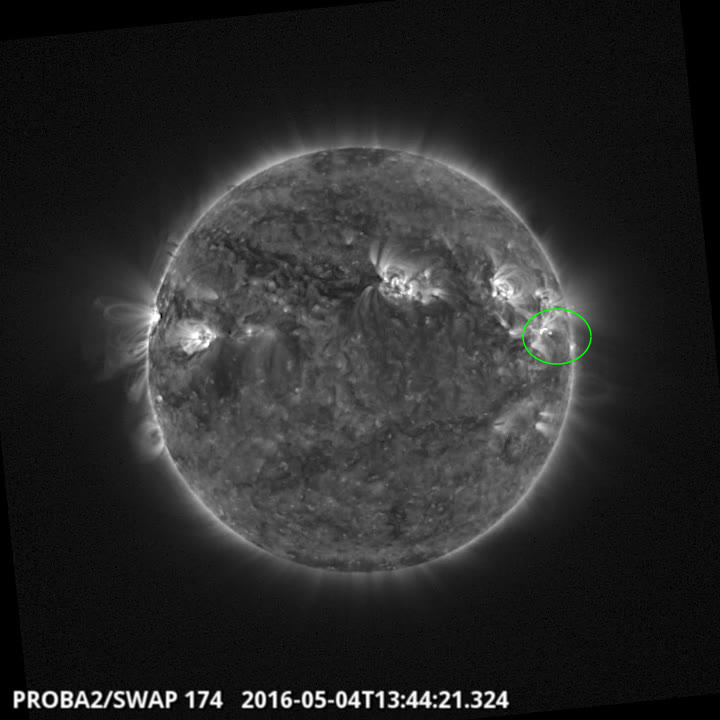
An eruption was observed by SWAP near the West limb of the Sun at 13:44 UT on 2016 May 04
Find a movie of the events here (SWAP movie)
http://proba2.oma.be/swap/data/mpg/movies/20160504_swap_movie.mp4
Saturday May 07
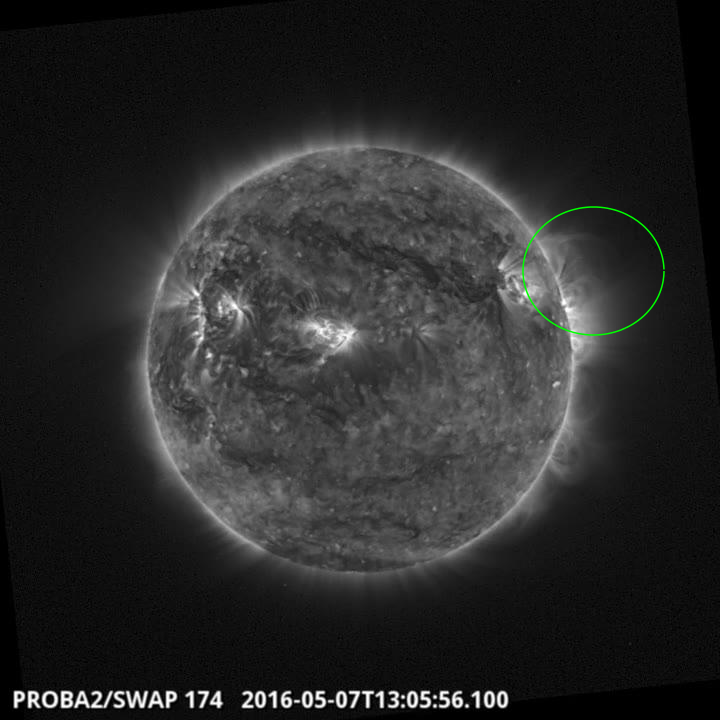
An eruption was observed by SWAP on the West limb of the Sun at 13:05 UT on 2016 May 07
Find a movie of the events here (SWAP movie)
http://proba2.oma.be/swap/data/mpg/movies/20160507_swap_movie.mp4
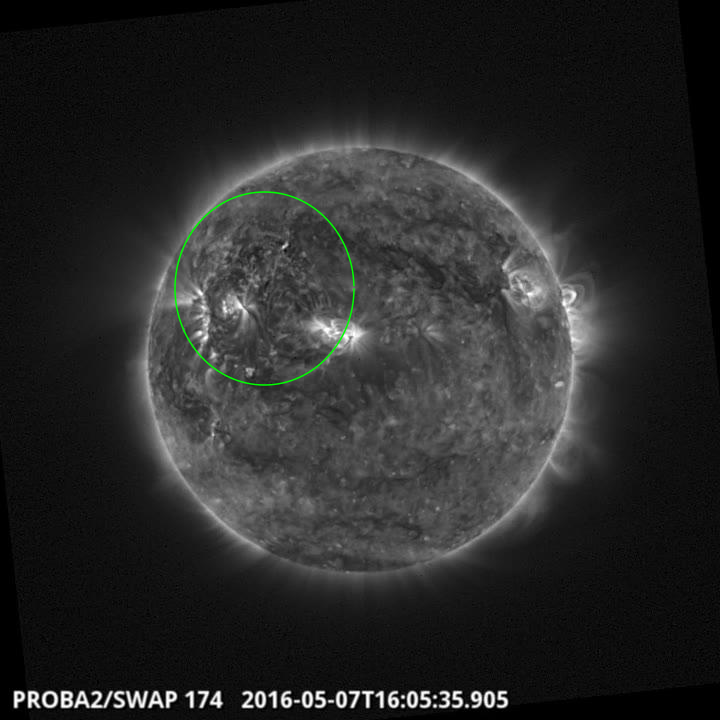
A confined eruption was observed by SWAP in the NorthEast quadrant of the Sun at 16:05 UT
on 2016 May 07
Find a movie of the events here (SWAP movie)
http://proba2.oma.be/swap/data/mpg/movies/20160507_swap_movie.mp4
Review of solar activity
Solar activity was very low with only 4 C-class and 21 B-class flares observed by the X-ray monitor onboard the satellite GOES.

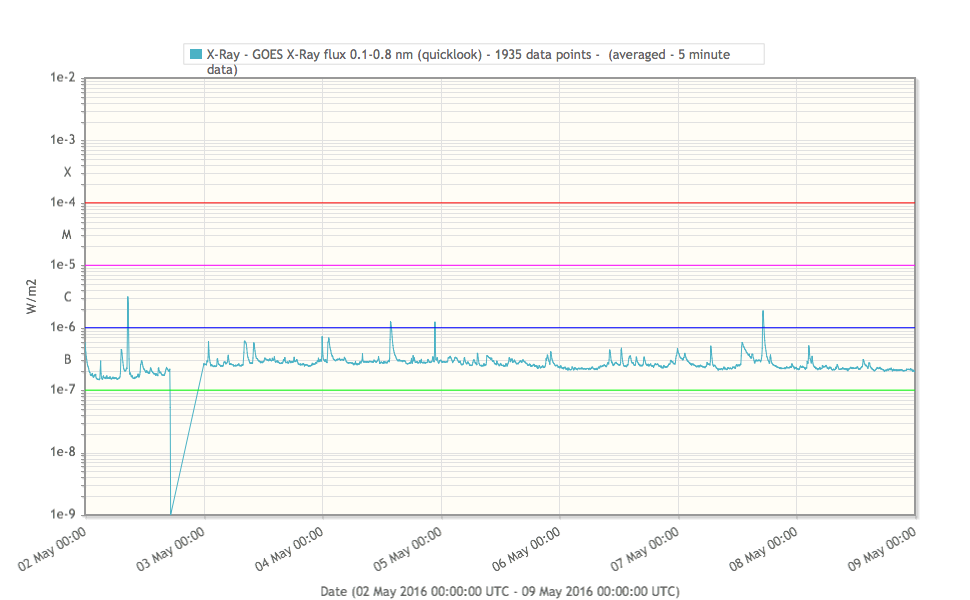
The strongest reported flare was the impulsive C3.5 flare (peaked at 08:42 UT) on May 02, which originated from the Catania sunspot group 71 (NOAA 2540). The flare was associated with an EIT wave, a type II radio burst (indicating the presence of the shock wave) and a weak, rather slow CME.
The most significant CME observed this week was first seen in the SOHO/LASCO C2 field of view at 14:12 UT on May 04, had angular width of about 90 degrees and projected speed of about 400 km/s (as reported by the CACTUS software).
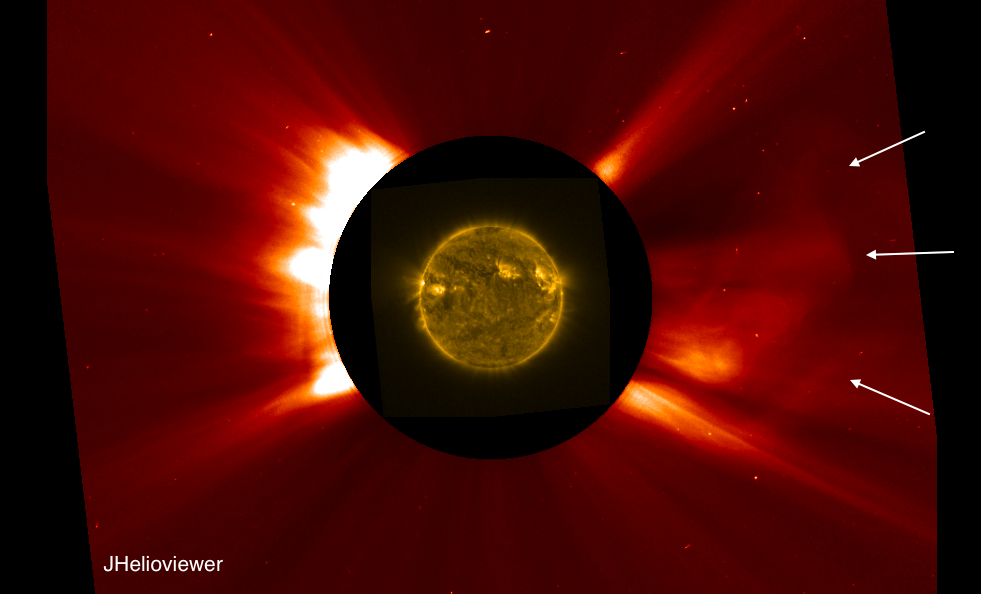
Two equatorial coronal holes were reported this week; first,a rather small equatorial coronal hole crossed the central meridian (CM) in the morning of May 03, and second, a large coronal hole crossed the central meridian early on May 06.
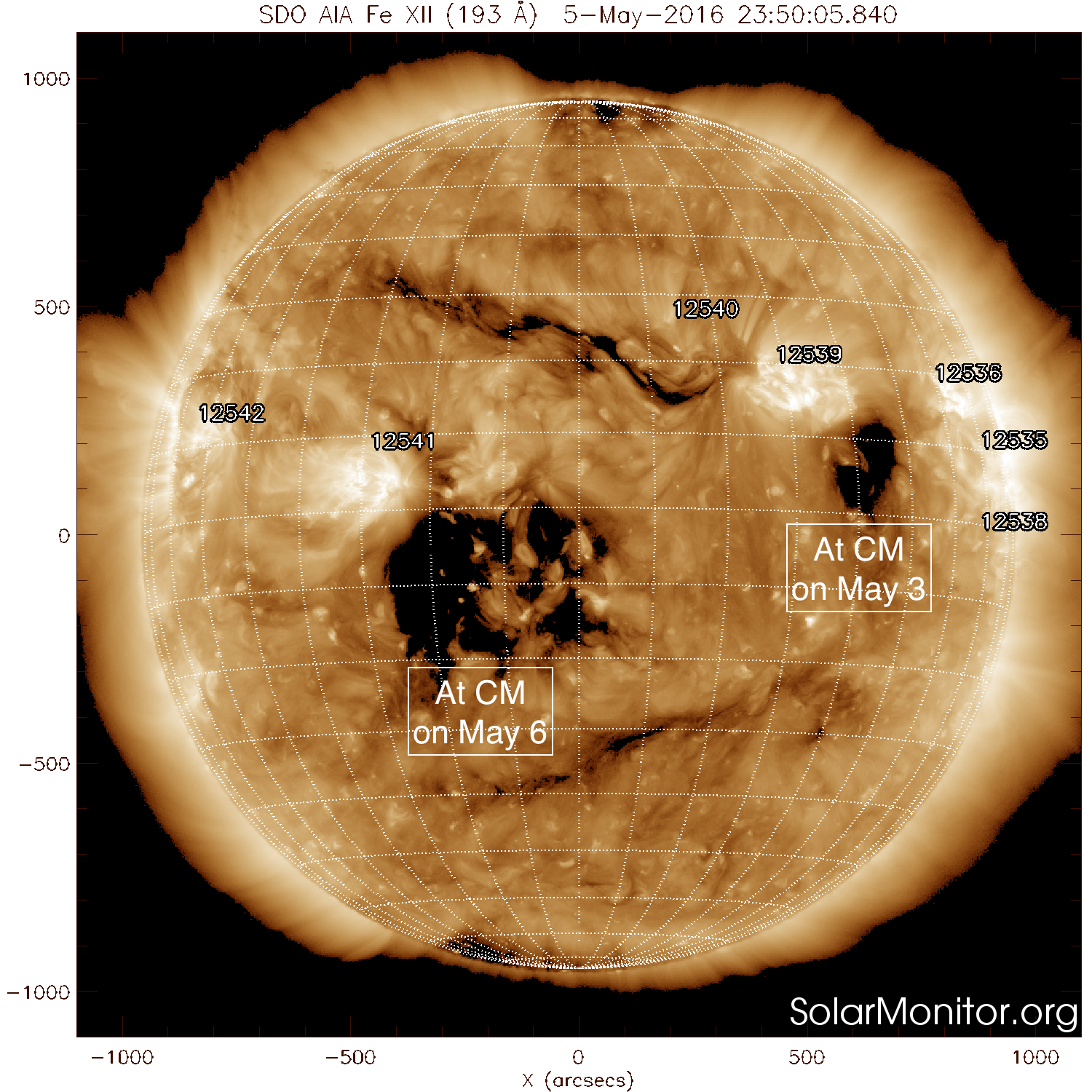
The International Sunspot Number
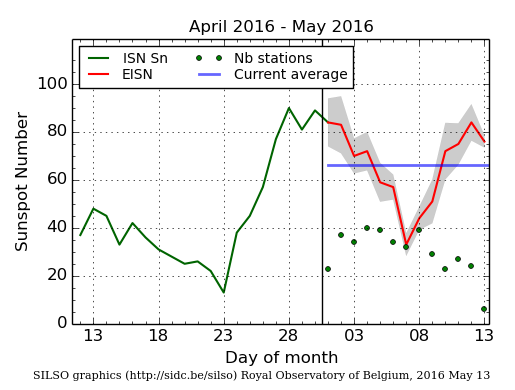
The daily Estimated International Sunspot Number (EISN, red curve with shaded error) derived by a simplified method from real-time data from the worldwide SILSO network. It extends the official Sunspot Number from the full processing of the preceding month (green line). The plot shows the last 30 days (about one solar rotation). The horizontal blue line shows the current monthly average, while the green dots give the number of stations included in the calculation of the EISN for each day.
Review of geomagnetic activity
This week, three fast flows arrived at the Earth and caused disturbed geomagnetic conditions.
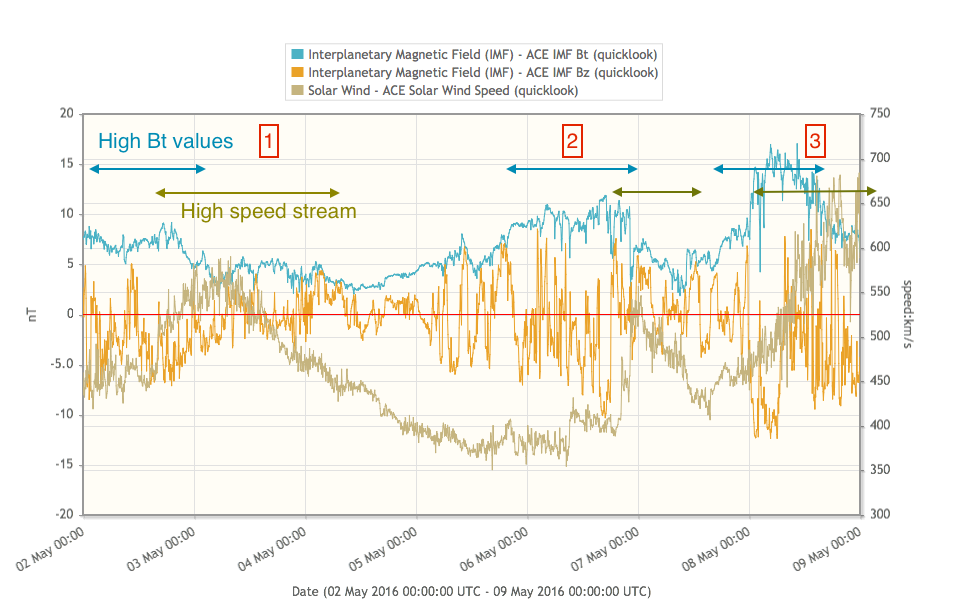
A first fast solar wind arrived on Monday, May 02: left two arrows in the above graph. The speed reached a value of about 560 km/s in the evening of May 02. The negative value of the Bz component of the interplanetary magnetic field (down to -7 nT) and the fast solar wind speed (about 500 km/s) induced geomagnetic storm conditions (NOAA reported planetary K index to be 6 and local station at Dourbes reported K=4) in the late evening of May 02 and early morning of May 03. This fast solar wind is probably associated with on of the two coronal holes which both reached the central meridian on April 26.
The simultaneous increase of the interplanetary magnetic field magnitude (up to 12 nT) and the oscillations of the Bz component of the interplanetary magnetic field, which started in the evening of May 05 indicated the upcoming arrival of a fast solar wind on May 06. The co-rotating interaction region and the fast flow induced geomagnetic storm conditions (NOAA reported planetary K index to be 5 and local station at Dourbes reported K=4) and was associated with the small equatorial coronal hole that reached the central meridian on May 03. Check the two arrows under the red 2 in the above graph.
The third period (2 right arrows) characterised by a fast solar wind speed was probably linked with the coronal hole that passed the central meridian on May 06. The long intervals of negative value of the Bz component of the interplanetary magnetic field (minimum value was about -15 nT) and the fast solar wind speed (maximum reached value was about 700 km/s) induced geomagnetic storm conditions which started at about 00:00 UT on May 08 and lasted for more than 24 hours. For the whole duration of the geomagnetic storm, the planetary K index reported by NOAA was never bellow K=5. In the early morning and around midnight of May 08 NOAA reported Kp=7 and local station at Dourbes reported K=5.
Review of ionospheric activity (2 May 2016 - 8 May 2016)
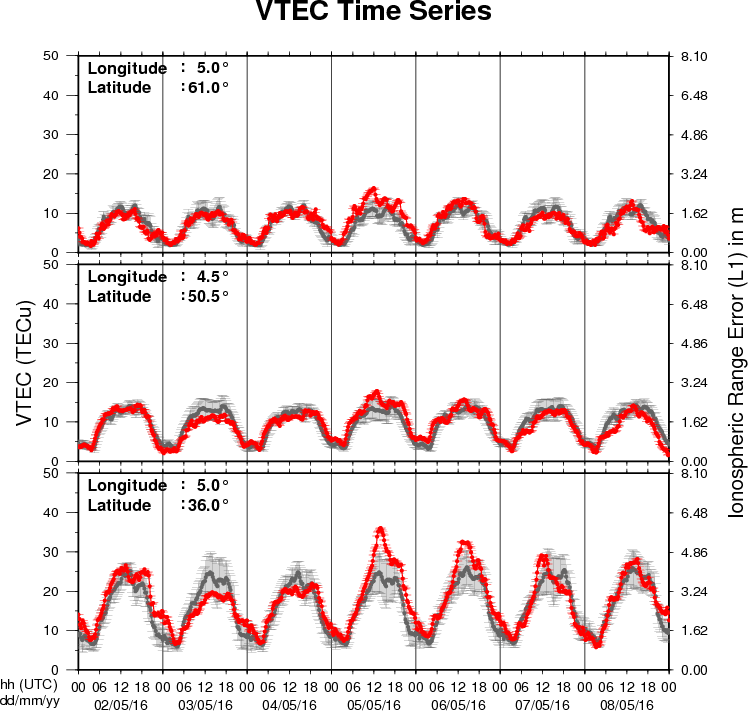
The figure shows the time evolution of the Vertical Total Electron Content (VTEC) (in red) during the last week at three locations:
a) in the northern part of Europe(N61°, 5°E)
b) above Brussels(N50.5°, 4.5°E)
c) in the southern part of Europe(N36°, 5°E)
This figure also shows (in grey) the normal ionospheric behaviour expected based on the median VTEC from the 15 previous days.
The VTEC is expressed in TECu (with TECu=10^16 electrons per square meter) and is directly related to the signal propagation delay due to the ionosphere (in figure: delay on GPS L1 frequency).
The Sun's radiation ionizes the Earth's upper atmosphere, the ionosphere, located from about 60km to 1000km above the Earth's surface.The ionization process in the ionosphere produces ions and free electrons. These electrons perturb the propagation of the GNSS (Global Navigation Satellite System) signals by inducing a so-called ionospheric delay.
See http://stce.be/newsletter/GNSS_final.pdf for some more explanations ; for detailed information, see http://gnss.be/ionosphere_tutorial.php
New documents in the European Space Weather Portal Repository
See http://www.spaceweather.eu/en/repository
STCE - De Zon
This is the theoretical course on the Sun and Spaceweather at the MIRA Solar Observatory in their lecture series for beginning amateur astronomers. Given on 13 April 2016 for 40 attendees.
http://www.spaceweather.eu/en/repository/show?id=600
STCE Annual Report 2014
The STCE Annual Report 2014 is a compilation of the activities done in 2014 within the frame of the Solar-Terrestrial Centre of Excellence (STCE). This report continues the style from the previous editions. Hence, as it is targeting a more general public, it presents only a selection of the 2014-activities in easy-to-digest summaries. These summaries emphasize the intense collaboration between the institutes at the Space Pole, as well as with our external partners. We hope you enjoy this report, which features articles on solar and space weather activity, the Open Doors at the Space Pole, the 11th European Space Weather Week, helmet streamers, a new solar coronagraph, total solar irradiance, the Belgian ALC network, SPENVIS-NG, and much more... Happy reading!
http://www.spaceweather.eu/en/repository/show?id=601
Future Events
For more details, see http://www.spaceweather.eu/en/event/future
Space Weather REDI Bootcamp
Start : 2016-06-07 - End : 2016-06-17
SW REDI summer Bootcamp is a two-week free training in space
weather, with the first week focusing on the fundamentals of space
weather and the second week on intensive forecaster training, with
alternative opportunities to discuss research topics with the CCMC
and NASA GSFC scientists.
The program is ideal for undergraduate and graduate students
interested in space weather forecasting or in space weather related
research but is also beneficial for scientists, engineers,
educators, mission operators, competitive high school students and
all others seeking to gain some basic knowledge regarding space
weather.
Website:
http://ccmc.gsfc.nasa.gov/support/SWREDI/bootcamp/
The Scientific Foundation of Space Weather
Start : 2016-06-27 - End : 2016-07-01
Website:
http://www.issibern.ch/program/workshops.html
Global Modelling of the Space Weather Chain in Helsinki, Finland
Start : 2016-10-24 - End : 2016-10-28
This event brings together solar, heliospheric, magnetospheric,
and ionospheric communities to discuss the current state and future
challenges in global modelling of the entire space weather chain.
Major developments in forecasting space weather, and understanding
the effects of solar eruptions requires increased communication and
collaboration of these often rather distinct communities. We
welcome submissions from these modelling communities and also
synergetic studies utilising both observations and numerical
models.
Website:
https://pnst.ias.u-psud.fr/sites/pnst/files/global_modelling_space_weather_oct2016.pdf
Solar Orbiter Workshop 7: Exploring the solar environs in Granada, Spain
Start : 2017-04-03 - End : 2017-04-06
This event will be hosted by the Instituto de Astrofisica de
Andalucia - CSIC. Please mind that on April 7th the 20th SWT
meeting will take place at the same venue.
Website: Unkown
